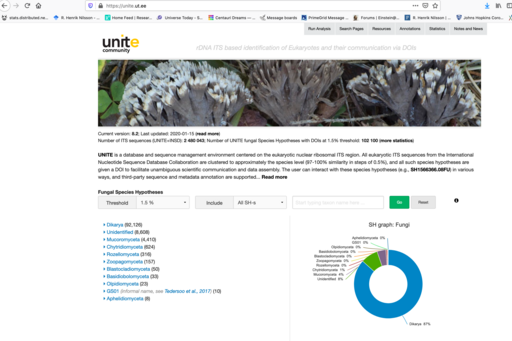
Mycology – taxonomy, systematics, ecology and evolution of fungi
Short description
Mycology studies the enigmatic fungal kingdom with its over 3 million extant species.
Members
Ellen Larsson, BioEnv
R. Henrik Nilsson, BioEnv
Sten Svantesson, BioEnv
More about our projects
Many fungi are subterranean or otherwise inconspicuous, and we now believe that a majority of the fungi never form mushrooms or other tangible morphological structures. Instead they are microscopic, hyphal- or yeast-based organisms characterized by a saprotrophic or symbiotic lifestyle. Indeed, fungi are the great decomposers and recyclers of nature, and they play far-reaching ecological roles in all ecosystems explored to date. Their inconspicuous nature means that mycology must to resort to cutting-edge tools in their study, notably DNA sequencing and genomics. These tools can be used to explore species boundaries, the evolutionary history of fungi, and in what substrates and habitats fungi are found. Our research group uses microscopy, DNA sequencing, and molecular ecology to expand mycology’s understanding of the fifth kingdom.
The mycological group at BioEnv focuses on taxonomy and systematics in their modern connotations. We use DNA sequence data to explore the evolutionary history of fungi, and we try to incorporate aspects of ecology and geography in that process. Mushrooms and the Agaricomycetes at large have been our focal taxa recently, but the research group also has a long history in corticioid mycology. Over the years we have unravelled multiple new species and several new orders, and we have made a range of startling ecological and biogeographical discoveries.
We also use DNA metabarcoding to compare entire fungal communities across ecosystems and substrates. Taxonomic reproducibility is key here, and our research group was one of the founders of the sequence reference database UNITE. We are still involved in its development, almost 20 years later. Over time, UNITE has grown into a full-fledged sequence management environment with functions and features at the very frontiers of science. UNITE provides reference data to a range of high-throughput sequencing pipelines and platforms, seeking to minimize the divide between fungal taxonomy and metabarcoding.

We are also interested in scientific publishing and dissemination of research and biodiversity data – and we feel that traditional scientific papers may not always be the best vehicle for that. We serve in a range of reference groups and boards working towards unified, reproducible, and accessible dissemination of research and research data to the scientific community and the public alike. We are active in various journal editorial boards, as reviewers of manuscripts and grant proposals, and at the Swedish Wikipedia pages.